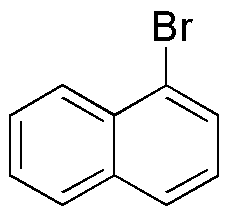1-Bromonaphthalene is widely utilized in research focused on:
- Synthesis of Organic Compounds: It serves as a key intermediate in the synthesis of various organic compounds, including pharmaceuticals and agrochemicals, allowing researchers to create complex molecules efficiently.
- Solvent Applications: This chemical is often used as a solvent in organic reactions, providing a non-polar environment that is essential for dissolving hydrophobic compounds, which is particularly beneficial in chemical laboratories.
- Material Science: In the field of material science, it is employed in the development of dyes and pigments, enhancing color properties and stability in various applications, such as textiles and coatings.
- Research in Environmental Chemistry: 1-Bromonaphthalene is used to study the behavior of polycyclic aromatic hydrocarbons (PAHs) in the environment, helping researchers understand pollution and its effects on ecosystems.
- Analytical Chemistry: It acts as a standard in chromatographic techniques, aiding in the identification and quantification of other compounds, which is crucial for quality control in various industries.
General Information
Properties
Safety and Regulations
Applications
1-Bromonaphthalene is widely utilized in research focused on:
- Synthesis of Organic Compounds: It serves as a key intermediate in the synthesis of various organic compounds, including pharmaceuticals and agrochemicals, allowing researchers to create complex molecules efficiently.
- Solvent Applications: This chemical is often used as a solvent in organic reactions, providing a non-polar environment that is essential for dissolving hydrophobic compounds, which is particularly beneficial in chemical laboratories.
- Material Science: In the field of material science, it is employed in the development of dyes and pigments, enhancing color properties and stability in various applications, such as textiles and coatings.
- Research in Environmental Chemistry: 1-Bromonaphthalene is used to study the behavior of polycyclic aromatic hydrocarbons (PAHs) in the environment, helping researchers understand pollution and its effects on ecosystems.
- Analytical Chemistry: It acts as a standard in chromatographic techniques, aiding in the identification and quantification of other compounds, which is crucial for quality control in various industries.
Documents
Safety Data Sheets (SDS)
The SDS provides comprehensive safety information on handling, storage, and disposal of the product.
Product Specification (PS)
The PS provides a comprehensive breakdown of the product’s properties, including chemical composition, physical state, purity, and storage requirements. It also details acceptable quality ranges and the product's intended applications.
Certificates of Analysis (COA)
Search for Certificates of Analysis (COA) by entering the products Lot Number. Lot and Batch Numbers can be found on a product’s label following the words ‘Lot’ or ‘Batch’.
*Catalog Number
*Lot Number
Certificates Of Origin (COO)
This COO confirms the country where the product was manufactured, and also details the materials and components used in it and whether it is derived from natural, synthetic, or other specific sources. This certificate may be required for customs, trade, and regulatory compliance.
*Catalog Number
*Lot Number
Safety Data Sheets (SDS)
The SDS provides comprehensive safety information on handling, storage, and disposal of the product.
DownloadProduct Specification (PS)
The PS provides a comprehensive breakdown of the product’s properties, including chemical composition, physical state, purity, and storage requirements. It also details acceptable quality ranges and the product's intended applications.
DownloadCertificates of Analysis (COA)
Search for Certificates of Analysis (COA) by entering the products Lot Number. Lot and Batch Numbers can be found on a product’s label following the words ‘Lot’ or ‘Batch’.
*Catalog Number
*Lot Number
Certificates Of Origin (COO)
This COO confirms the country where the product was manufactured, and also details the materials and components used in it and whether it is derived from natural, synthetic, or other specific sources. This certificate may be required for customs, trade, and regulatory compliance.


